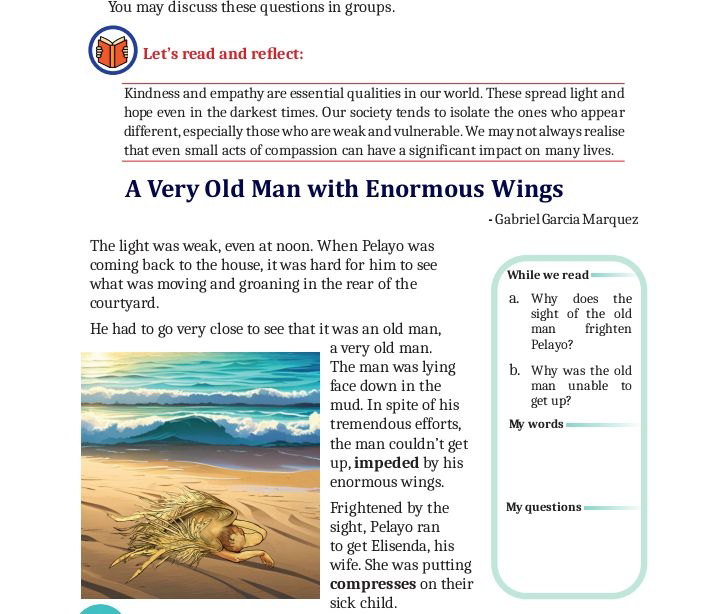MENDING WALL
MENDING WALL
- Robert Frost
Activity - I (Paragraph writing)
Elaborate the idea in the following line in a paragraph:
“Good fences make good neighbours.”
Good fences make good neighbours means it is good to have some limits between neighbours so that their relations will remain healthy at all times. If there is unlimited freedom between neighbours, trouble will soon start. Suppose you grow goats in your house. Your neighbour has a vegetable garden. If there is no fence your goats will go and eat up the vegetables of your neighbour. Will he like it?
Suppose your neighbour’s children come and open your fridge and eat up all the good food you have kept there. Will you like it? So there must be some boundaries between-neighbours and only then there will be good relations.
Activity - II ( Appreciation)
The central idea of the poem:
The central idea of the poem is that nature does not
like separation and that is why it tends to destroy the walls. But for healthy relations walls or fences are necessary. If there are no boundaries between neighbours, their relation will not last long. Good fences make good neighbours.
The central idea of the poem is that nature does not
like separation and that is why it tends to destroy the walls. But for healthy relations walls or fences are necessary. If there are no boundaries between neighbours, their relation will not last long. Good fences make good neighbours.
Symbolic significance of wall in the poem:
The ‘wall’ symbolizes the restrictions between neighbours. Even if you love your neighbour dearly, you can’t give him unlimited freedom in your house. Wall symbolizes such boundaries.
Poetic devices employed by the poet:
The poet has employed many devices to make his poem effective. The poem has fine rhythm. He has used a fine metaphor in calling the boulders as loaves and balls. He has used a lot of humour: the hunters finding rabbits for their dogs, his command to the stones to stay in place till his back is turned, and calling his neighbour as a stone age man with stones as weapons in his hands.
His logic of his apple trees not going to eat the pine cones in his neighbour’s estate is very funny. He has used a simile when he says that the two neighbours keeping the stones back was like an outdoor game. There is personification when he tells the boulders ‘Stay where you are.’ Here he thinks the boulders to be some kind of mischievous children who would run away the moment their parents’ eyes are off. There is parallelism in the use of ‘Good fences make good neighbours’.
There is excellent imagery in the poem. We see how Spring Season causes the ground to swell and loosen the boulders. We can see the hunters trespassing with their barking dogs. They are trying to shoot rabbits. We can see the apple trees and the fine trees. We can see the neighbours walking on either side of the wall, fixing the fallen stones and the stones falling down as soon as they turn their backs.
Language:
Robert Frost has used very simple but vivid language to write his poem. There are not many words which are unknown to us. The sentences are simple and there are no complexities in the construction. Anybody who knows some English can get the meaning clearly. Essentially Frost is a Romantic poet who loved simplicity in language. Although it is a fine poem, it is very close to the structure of prose and so understanding it is very easy. Only a great poet can do such a thing – make a fine poem using simple words.
Structure:
The poem has a simple structure. The poem proceeds with the ease of a story told by a master. There are no twists and turns and everything is clear without any mystification or complication. Frost’s structure is always easy pleasing to the eye and pleasing to the mind.
The poem has a simple structure. The poem proceeds with the ease of a story told by a master. There are no twists and turns and everything is clear without any mystification or complication. Frost’s structure is always easy pleasing to the eye and pleasing to the mind.
Now, prepare a note of appreciation of the poem ‘Mending Wall’:
Frost once said, “A poem begins in delight and ends in wisdom.” The poem ‘Mending Wall’ proves his theory. He starts his poem in a delightful way saying that there is something that does not like a wall. He does not say what that ‘something’ is. That ‘something’ makes the ground under the wall swell which results in cracks in the wall. Gradually the stones that make the wall fall to either side.
The fallen stones have lost their shapes. Some look like loaves of bread and others look like balls. It will need some spell or magic to keep the stones balanced on the wall even for a short time. The poet has to command the stones to stay in place at least till he and his neighbour have turned their backs on them. He knows very well that they won’t stay there for long.
The gaps in the walls are so big that even two people can pass through them walking side by side. It is funny that nobody ever sees and hears anybody breaking the wall. But every spring time the walls are broken and the people have to repair them. Frost feels there is no need for a wall between him and his neighbour. His neighbour grows pine and he grows apple trees. Will apple tress go and eat the cones of the pine? Why should there be a wall?
A wall was fine if they had cows. Cows could get mixed up. Frost tells his neighbour there is no need fora wall. But the neighbour insists that good fences make good neighbours.
Frost has used many poetic devises to make is poem a fine one. He has used metaphor, simile, personification.



Comments
Post a Comment
Please share your feedback and questions